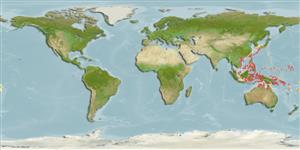>
Gobiiformes (Gobies) >
Gobiidae (Gobies) > Gobiinae
Etymology: Trimma: Greek, trimma, -atos = something crushed (Ref. 45335); hayashii: Named for Mr. Masayoshi Hayashi.
Eponymy: Dr Masayoshi Hayashi is Curator, Yokosuka City Museum. [...] (Ref. 128868), visit book page.
More on authors: Hagiwara & Winterbottom.
Environment: milieu / Zona climática / intervalo de profundidade / distribution range
Ecologia
marinhas associadas(os) a recifes; intervalo de profundidade 0 - 26 m (Ref. 58123). Subtropical
Western Pacific: Japan to the Solomons.
Tamanho / Peso / Idade
Maturidade: Lm ? range ? - ? cm
Max length : 2.3 cm SL macho/indeterminado; (Ref. 58123)
Descrição suscinta
Chaves de identificação | Morfologia | Morfometria
Espinhos dorsais (total) : 7; Raios dorsais (total) : 8 - 9; Espinhos anais: 1; Raios anais : 7 - 8. This species is characterized by the following: dorsal spine a little elongated or not; presence of a basal membrane between the pelvic fins; absence of predorsal scales; an interorbital but no postorbital trench; absence of cheek and opercular scales; fifth pelvic fin ray branched sequentially once or twice and, uniquely among known species of Trimma, has a bilateral, pupil-sized black spot on the branchiostegal membrane; live individuals with red spots, a little smaller than the pupil diameter on the head and nape, the posterior half of body has 3 yellow stripes separated by 2 grey stripes, and the black spots on the branchiostegal membranes are ocellated with white or blue (Ref. 58123).
Body shape (shape guide): fusiform / normal; Cross section: oval.
Lives under corals in embayments, which are sometimes covered by siltation. Also found in caves and crevices of sheltered reefs (Ref. 90102). It often positions itself upside-down on the roof of the recess (Ref. 58123).
Ciclo de vida ou comportamento de acasalamento
Maturidade | Reprodução | Desova | Ovos | Fecundidade | Larvas
Hagiwara, K. and R. Winterbottom, 2007. Two new species of Trimma (Gobiidae) from the Western Pacific. Bull. Natl. Mus. Nat. Sci., Ser. A, Suppl. 1:163-174. (Ref. 58123)
Status na Lista Vermelha da UICN (Ref. 130435: Version 2025-1)
Ameaça para os humanos
Harmless
Uso pelos humanos
Pescarias: sem interesse
Ferramentas
Relatórios especiais
Baixar XML
Fontes da internet
Estimates based on models
Preferred temperature (Ref.
123201): 25.3 - 29.3, mean 28.7 °C (based on 1246 cells).
Índice de diversidade filogenética (Ref.
82804): PD
50 = 0.5000 [Uniqueness, from 0.5 = low to 2.0 = high].
Bayesian length-weight: a=0.01023 (0.00477 - 0.02194), b=3.01 (2.83 - 3.19), in cm total length, based on LWR estimates for this (Sub)family-body shape (Ref.
93245).
Resiliência (Ref.
120179): Elevada, tempo mínimo de duplicação da população menor que 15 meses (Preliminary K or Fecundity.).
Fishing Vulnerability (Ref.
59153): Low vulnerability (10 of 100).
🛈
Nutrients (Ref.
124155): Calcium = 258 [88, 845] mg/100g; Iron = 1.74 [0.70, 4.09] mg/100g; Protein = 18.7 [16.5, 20.7] %; Omega3 = 0.254 [0.080, 0.784] g/100g; Selenium = 14.2 [3.9, 42.1] μg/100g; VitaminA = 77.4 [13.4, 432.1] μg/100g; Zinc = 3.07 [1.55, 5.49] mg/100g (wet weight);
